Corrosion is often called the “silent killer” of pumps and nowhere is this truer than in the impeller. As the rotating heart of the pump, the impeller is constantly exposed to fluid forces, pressure variations, and sometimes highly aggressive chemicals. When corrosion sets in, efficiency drops, energy use spikes, and in severe cases, entire systems can grind to a halt.
The impact isn’t minor. Pumps account for nearly 20–30% of industrial energy consumption, making them one of the biggest operational cost centers in sectors like chemicals, power, and water treatment.
An impeller weakened by corrosion not only shortens pump life but also drives up maintenance costs and unplanned downtime two things no operation can afford in today’s competitive, efficiency-driven industries.
This guide will take you through the essentials of pump impeller corrosion: what it is, why it happens, and, most importantly, how you can prevent it. From material selection and coatings to smarter installation and modern predictive maintenance, you’ll learn how to make informed decisions that protect your pumps and maximize their lifecycle value.
Key Takeaways
- Impeller corrosion is the “silent killer” of pumps, it reduces hydraulic efficiency, increases energy costs, and shortens service life long before visible damage appears.
- The root causes are multi-layered, poor material-to-fluid compatibility, galvanic reactions between dissimilar metals, cavitation stress, slurry abrasion, and water chemistry.
- Material choice is critical, cast iron is cheap but vulnerable, stainless steel (304/316) works well in many industries, bronze/duplex steels thrive in marine environments, and thermoplastics like PFA/PVDF are unbeatable for strong acids/solvents.
- Prevention is a layered strategy, right material selection, protective coatings, correct installation to avoid cavitation, scheduled maintenance, and smart monitoring (IoT + AI predictive analytics).
- Industry context matters, corrosion risks vary by sector (chemical, wastewater, agriculture, marine, mining, power). No single impeller material works everywhere; tailored solutions like those from Chemitek ensure longer life and lower lifecycle costs.
What is Pump Impeller Corrosion?
Pump impeller corrosion refers to the gradual material loss that occurs when the impeller the rotating component responsible for imparting energy to the fluid deteriorates due to chemical, electrochemical, or mechanical reactions with the fluid being handled.
While pump corrosion often describes wear across the entire unit (casings, seals, shafts), impeller corrosion is more critical because the impeller directly impacts hydraulic efficiency, flow rate, and service life. Even minor surface pitting on the impeller can reduce efficiency and lead to costly downtime.
Types of Corrosion Affecting Pump Impellers
1. Uniform Corrosion

- A steady, even material loss across the impeller surface.
- Impact: Predictable but relentless, gradually thinning impeller walls and lowering efficiency.
- Where you’ll see it: Pumps handling mildly aggressive fluids in industries like municipal water treatment or food processing, where the entire surface is exposed to uniform attack.
2. Pitting Corrosion

- Localized damage that creates small but deep pits or holes.
- Impact: Dangerous because pits are hard to detect early, yet they can lead to sudden impeller rupture.
- Where you’ll see it: Common in desalination plants, coastal pump stations, and chemical industries with chloride-rich or saline fluids.
3. Galvanic Corrosion
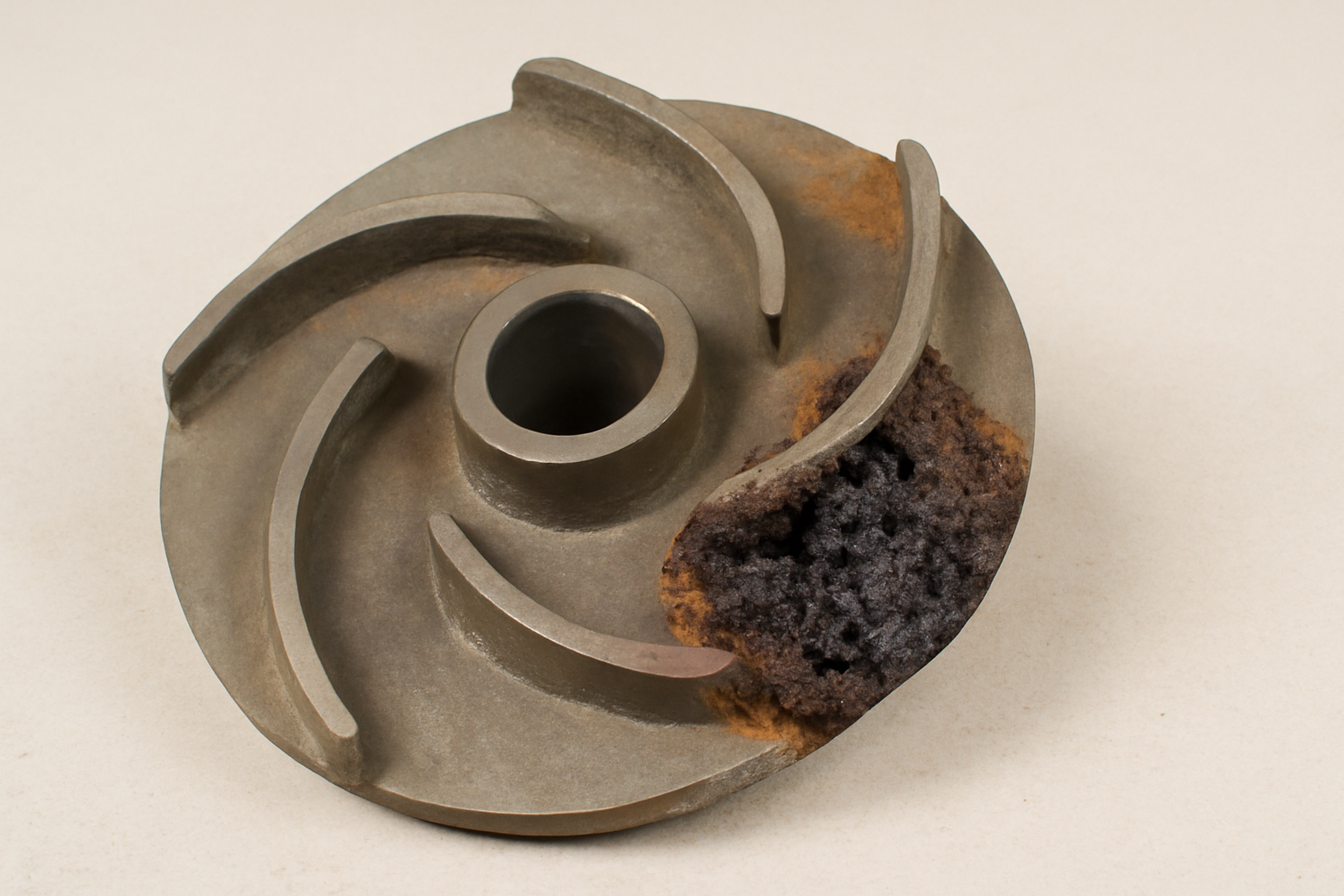
- Occurs when two dissimilar metals (e.g., stainless steel impeller with a cast iron casing) are in electrical contact in a conductive fluid.
- Impact: The less noble metal corrodes faster, creating weak points in the impeller.
- Where you’ll see it: Frequently in marine applications and wastewater pumps, where assemblies mix alloys under high conductivity conditions.
4. Cavitation-Induced Erosion-Corrosion
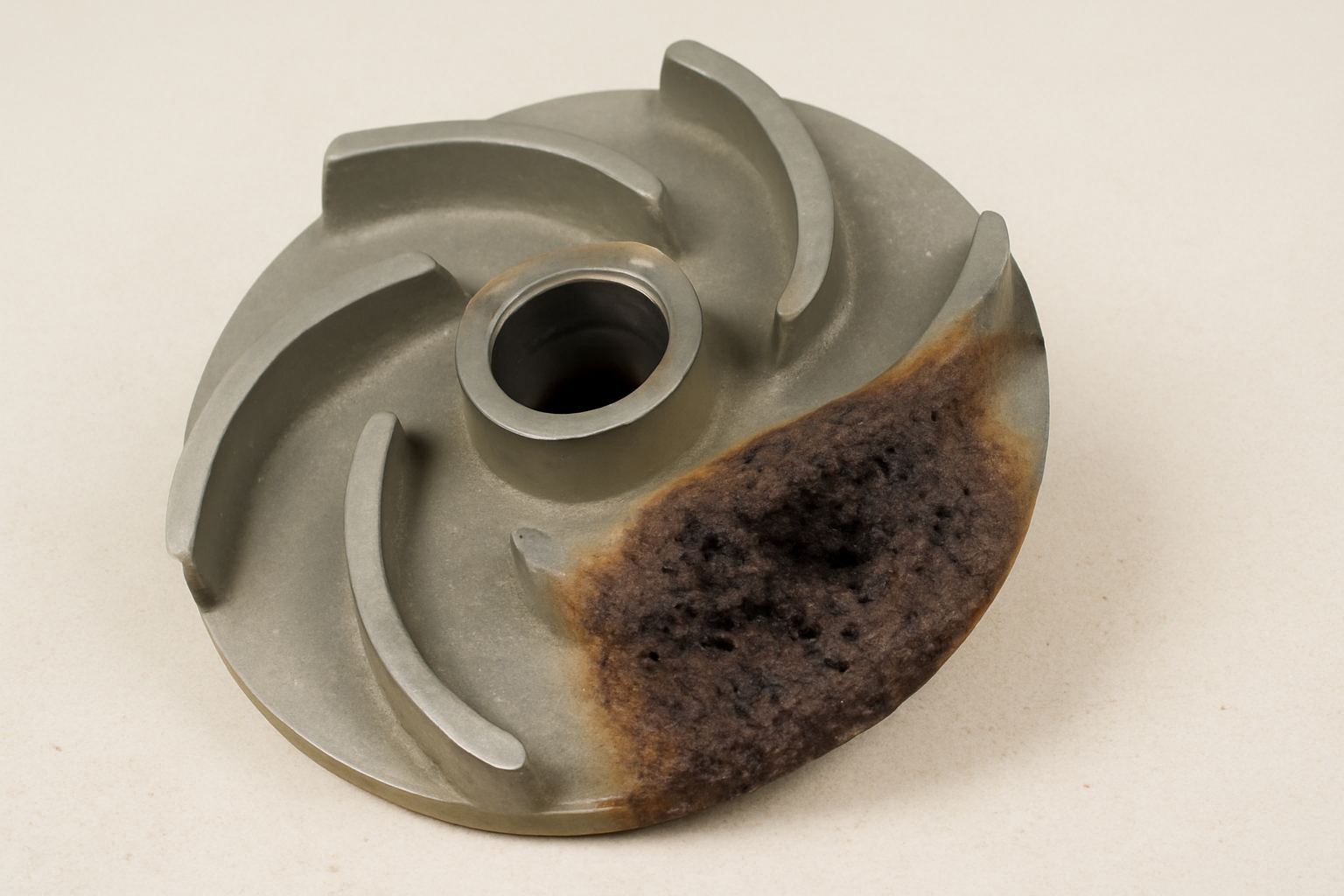
- Unique to pump environments caused by vapor bubbles collapsing violently against the impeller surface.
- Impact: Strips away protective films, leaving a rough, sponge-like surface that accelerates corrosion.
- Where you’ll see it: High-speed or poorly designed pumps in thermal power plants, chemical processes, and slurry handling, especially under poor NPSH conditions.
Corrosion vs. Erosion: Key Difference
- Corrosion: A chemical or electrochemical process, where the impeller material reacts with the fluid (e.g., acid attacking stainless steel).
- Erosion: A mechanical process, where suspended particles or collapsing vapor bubbles physically wear away the material.
In practice, pumps often face erosion-corrosion, where both processes work together corrosion weakens the metal’s surface, while erosion accelerates the removal of already-damaged material.
Causes of Pump Impeller Corrosion
Pump impellers don’t just corrode because “that’s what metals do in liquid.” The real drivers are a mix of operating conditions, fluid chemistry, and design choices that accelerate wear. Below are the key factors you should understand:
- Fluid Chemistry Mismatch
The number one cause of impeller failure is poor material-to-fluid compatibility. A cast iron impeller in a chloride-rich environment will pit rapidly, while stainless steel may perform well against acids but fail in alkaline slurries.
Choosing the wrong metallurgy sets the stage for early corrosion. - Mixed-Metal Assemblies (Galvanic Hotspots)
Pumps often use multiple metals across the casing, impeller, and shaft. When exposed to conductive fluids (like seawater), these dissimilar metals create galvanic cells where one acts as the sacrificial anode.
Even small fasteners or sleeves of different alloys can trigger localized impeller corrosion. - Hydraulic Stress & Cavitation Conditions
Impellers operating outside their Best Efficiency Point (BEP) experience uneven pressure zones.
This can create microbubbles (cavitation) that implode against the impeller blades, breaking protective oxide layers and opening fresh metal to corrosion. It’s not just about flow rates it’s about how consistently the pump is run near its design point. - Abrasive & Corrosive Dual Attack
Slurry pumps face the worst of both worlds: solids like sand erode protective coatings, while corrosive fluids immediately attack the exposed fresh metal underneath.
This cycle dramatically accelerates impeller wear compared to pure chemical corrosion. - Water Chemistry & Environment
Even “clean” water isn’t always safe. Chlorides in coastal supplies, dissolved oxygen in aerated tanks, or varying pH levels in wastewater create micro-environments for corrosion.
For pumps operating near marine docks, desalination plants, or wastewater facilities, water chemistry is often the hidden villain.
Together, these factors explain why pump impeller corrosion isn’t just about the pump design but also about fluid chemistry, operating conditions, and installation environment. Addressing the root cause is key to long-term reliability.
Signs & Impacts of Pump Impeller Corrosion
Corrosion doesn’t just damage the impeller surface it quietly drains efficiency, drives up costs, and shortens pump life. Knowing the signs early helps operators avoid expensive downtime.
Visible Signs of Corrosion
- Pitting and surface roughness: small cavities or holes that weaken impeller blades.
- Material thinning: impeller vanes become visibly worn or uneven.
- Rust deposits or discoloration: early indicators of chemical attack.
- Minor leaks: often a symptom of seal degradation caused by corroded impellers.
Operational Impacts
- Drop in hydraulic efficiency: even a 10% efficiency loss can translate into thousands of dollars in extra energy costs over a pump’s life.
- Higher vibration and noise: corroded impellers throw pumps off balance, straining bearings and seals.
- Frequent breakdowns: corrosion accelerates fatigue, causing repeated repairs and downtime.
- Escalating lifecycle costs: more spares, longer maintenance cycles, and lost production hours.
- Safety risks in critical plants: in power, chemical, or marine systems, impeller failure can escalate into leaks or hazardous shutdowns.
Corrosion is never just cosmetic, by the time you see visible damage, your pump is already running below its designed efficiency.
To avoid costly downtime and performance losses, prevention must start early: with smart material choices, protective coatings, correct operation, and proactive monitoring.
How to Prevent Pump Impeller Corrosion
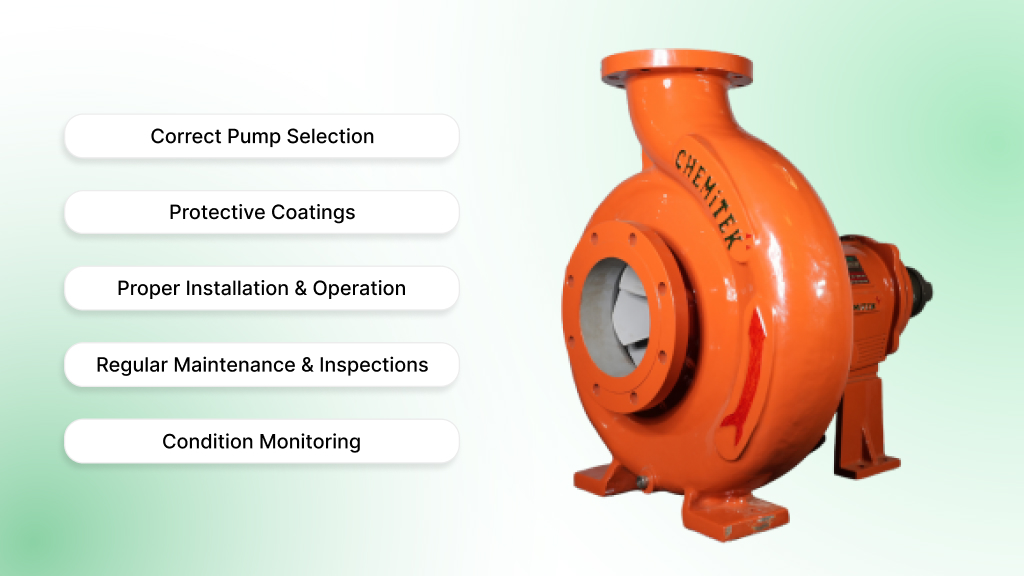
Corrosion control is never about a single fix it’s a layered strategy combining the right design, materials, and maintenance. Here’s how industries can effectively extend impeller life:
Correct Pump Selection
The first and most important step is selecting a pump and impeller material compatible with the fluid being handled. A mismatch here sets the stage for premature corrosion, no matter how good your coatings or maintenance routines are.
- Cast Iron: Low-cost and durable for clean water, but corrodes quickly in acidic or alkaline environments.
- Stainless Steel (304/316): A workhorse in food, pharma, and chemical industries; resists most corrosive fluids, though chloride-rich waters can still cause pitting.
- Bronze & Duplex Steel: Bronze works well in seawater, while duplex stainless steels offer extra strength and corrosion resistance in highly aggressive conditions.
- Thermoplastics (PFA, PVDF, Polypropylene): Critical for highly corrosive acids, alkalis, and solvents where metals fail.
Tip: Always cross-check your fluid against a chemical compatibility chart before purchase. Standards like ANSI B73.1 and API set material guidelines for pumps used in corrosive and hazardous services a detail many overlook, but it can save thousands in avoided failures.
Protective Coatings
Even when the right material is used, coatings provide an added shield, reducing direct contact between the impeller and aggressive fluids.
- Epoxy Coatings: economical, good for mild water and wastewater duty.
- Ceramic Linings: resist abrasive slurries in mining, dredging, or sewage systems.
- Polymer Linings (Fluoropolymers like PTFE/PFA): excellent chemical resistance for acids and solvents.
Use coatings strategically: don’t over-apply where unnecessary, since coatings can crack under high stress if not selected properly.
Proper Installation & Operation
Most impeller failures aren’t due to poor materials they stem from pumps being run outside their design envelope.
- Cavitation Control: Ensure adequate NPSH (Net Positive Suction Head) and avoid operating pumps too far from their Best Efficiency Point (BEP). Cavitation damage often looks like corrosion but is preventable with correct setup.
- Alignment & Sealing: Shaft misalignment or faulty seals can introduce air pockets, accelerating localized corrosion.
- Steady Operation: Avoid frequent start-stops, overspeeding, or running dry, all of which stress the impeller surface.
Regular Maintenance & Inspections
Impeller corrosion usually starts microscopically before it becomes visible. Consistent inspections help catch problems early.
- Visual Checks: Look for thinning blades, rust flakes, or coating wear.
- Performance Monitoring: A sudden drop in flow rate or rise in energy use often signals early-stage corrosion.
- Vibration & Noise Analysis: Imbalance caused by pitting or uneven wear creates tell-tale vibration patterns.
- Fluid Quality Tests: Checking pH, chloride content, and dissolved oxygen helps anticipate corrosion in advance.
Treat inspections as predictive, not reactive this saves far more than waiting until visible failure.
Condition Monitoring
Corrosion prevention is moving beyond manual inspections into smart monitoring.
- IoT-Enabled Sensors: Track vibration, temperature, and flow rates in real time.
- Predictive Analytics: AI models can detect corrosion or cavitation weeks before failure.
- System Integration: Linking pumps with SCADA systems allows scheduling proactive maintenance and reducing downtime.
Corrosion prevention strategies are universal, but their effectiveness depends heavily on the industry environment where the pump operates. What works in agriculture may fail in marine desalination, and a coating that protects in wastewater may not hold up in chemical processing. Let’s map the risks and material choices for different industries.
Industry-Specific Applications & Risks of Impeller Corrosion
Corrosion risks don’t play out the same way in every industry. Each sector handles different fluids, temperatures, and operating conditions meaning the way impellers degrade, and the materials best suited to resist it, vary widely.
Mapping corrosion risks to industries helps make more precise, cost-effective decisions rather than relying on generic guidelines.
Industry challenges are diverse, but the common thread is clear: pumps must be engineered for their environment. This is where specialized manufacturers stand apart.
Among Indian manufacturers, few specialize exclusively in corrosion resistance. One such example is Chemitek Process Equipments, which has built its reputation on delivering corrosion-resistant pumps designed to tackle the very risks we’ve mapped above.
Chemitek: Proven Corrosion-Resistant Pump Solutions
After exploring how corrosion risks vary across industries, let’s look at how Chemitek specifically addresses these challenges with smart design and material expertise.
Why Chemitek Stands Out
- Specialized in Corrosive Duty: Chemitek offers both ANSI B73.1-compliant metallic and non‑metallic pumps designed for aggressive acids, alkalis, solvents, and slurry conditions .
- Industries Served: Our pumps are engineered for corrosive applications across key sectors including chemicals, fertilizers, pharmaceuticals, dyes, steel, sugar, water treatment, and effluent handling .
- Advanced Construction: We use precision investment casting for metallic designs with high-temperature tolerance (up to 350 °C), and thick fluoropolymer (PFA, PVDF) non‑metallic designs to withstand corrosive fluids .
- Tailored Engineering & Support: Chemitek delivers custom pump solutions that align precisely with your process needs including fluid compatibility, hydraulic requirements, and temperature backed by proactive maintenance and technical consultation .
How Chemitek Maps to Industry Risks
Chemitek demonstrates how manufacturers can go beyond one-size-fits-all pumps by aligning material choice and design with each industry’s unique corrosion challenges.
If your application involves highly corrosive or abrasive fluids, Chemitek’s tailored approach is exactly the kind of solution that ensures long-lasting, efficient pump performance.
Emerging Solutions to Combat Corrosion
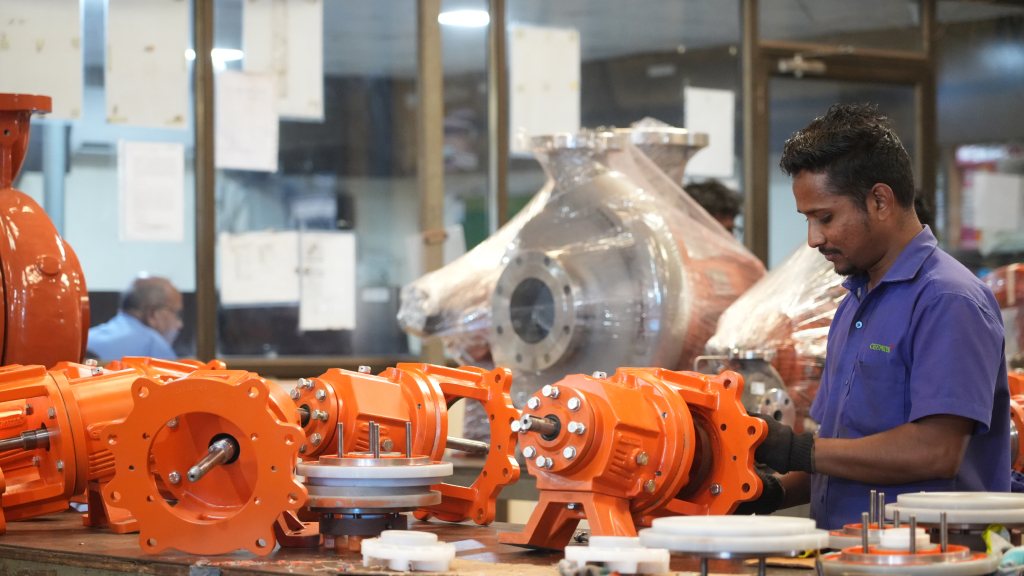
The fight against pump impeller corrosion isn’t standing still. Beyond traditional fixes like better materials and coatings, the industry is now exploring smarter, greener, and more predictive ways to extend pump life and cut costs.
These emerging solutions signal where corrosion control is headed in the next decade.
1. Smart Pumps with IoT-Based Corrosion Monitoring
Next-gen centrifugal pumps are being equipped with IoT sensors that track vibration, temperature, flow rates, and even surface condition in real time.
Instead of waiting for visible pitting or efficiency loss, operators can see early warning signs of corrosion directly on dashboards.
Impact: Reduces unplanned downtime by flagging issues before failure.
2. AI-Powered Predictive Maintenance in High-Value Industries
Artificial intelligence is being integrated into pump monitoring systems to analyze sensor data and detect micro-patterns invisible to the human eye. Especially in power plants, oil & gas, and pharma facilities where pump failure can cost millions in downtime.
Benefit: AI can predict failures weeks in advance, allowing planned shutdowns instead of emergency breakdowns.
3. Green Materials & Recyclable Alloys
Sustainability is becoming just as important as reliability. Manufacturers are experimenting with recyclable alloys, duplex stainless steels, and environmentally friendly coatings that reduce waste and align with Net Zero commitments.
Advantage: Meets stricter environmental compliance while extending service life.
4. Solar-Driven Pumps with Corrosion-Resistant Impellers
In agriculture, solar-powered centrifugal pumps are not only cutting energy costs but also increasingly designed with stainless steel or polymer impellers that resist corrosion in variable water quality conditions.
Why it matters: Farmers save on electricity/fuel costs while gaining longer pump life.
These solutions show that corrosion management is moving from being purely reactive (replace when broken) to proactive and sustainable (monitor, predict, and design smarter).
Conclusion: Managing Corrosion, Extending Pump Life
Pump impeller corrosion isn’t just an engineering inconvenience, it’s a direct threat to efficiency, uptime, and operating costs. From chemical attack and cavitation to abrasive slurries and poor water quality, the risks are varied but the outcome is the same: reduced efficiency and higher lifecycle costs if left unchecked.
What this guide has shown is that corrosion doesn’t have to dictate pump performance.
- By understanding why it happens, operators can avoid common design and material pitfalls.
- By recognizing the warning signs early, costly breakdowns can be prevented.
- By applying layered prevention strategies smart material choices, protective coatings, proper operation, and predictive monitoring pump life can be extended significantly.
- By embracing emerging solutions like IoT-enabled monitoring, AI-driven maintenance, and sustainable alloys, industries can stay ahead of the curve.
Corrosion is inevitable, but its pace and cost are fully controllable. With the right approach, impellers stop being the weak link and instead become long-term assets supporting efficiency, safety, and profitability.
If your operations involve aggressive fluids or demanding conditions, a standard pump will fall short. Chemitek delivers corrosion-resistant centrifugal pumps, engineered with advanced materials (metallic and non-metallic) and tailored for sectors such as chemicals, fertilizers, steel, textiles, water treatment, and pharmaceuticals.
Request a compatibility assessment or explore Chemitek’s corrosion-resistant pump portfolio to secure reliable performance in even the harshest operating environments.
FAQs on Pump Impeller Corrosion
Q1. What is the main cause of pump impeller corrosion?
The biggest cause is poor material-to-fluid compatibility. For example, cast iron corrodes quickly in chloride-rich water, while stainless steel may fail against strong alkalis. Cavitation and abrasive slurries often worsen the problem.
Q2. How can you identify early signs of impeller corrosion?
Early signs include pitting, rough surfaces, rust deposits, and rising vibration/noise levels. A noticeable drop in flow rate or higher energy bills is often a hidden indicator before visible damage shows up.
Q3. Which impeller materials are best for resisting corrosion?
For corrosive fluids: duplex stainless steel, bronze, or superalloys. For strong acids and solvents: non-metallics like PFA, PVDF, or polypropylene. The choice depends on the exact chemical environment.
Q4. Can pump impeller corrosion be repaired, or does it always require replacement?
Minor corrosion can sometimes be repaired with coatings or resurfacing, but severe pitting, thinning, or imbalance usually requires a full replacement to avoid catastrophic failure.
Q5. How much can impeller corrosion affect pump efficiency and costs?
Even a 10% loss in hydraulic efficiency from corroded impellers can translate into thousands of dollars in extra energy and maintenance costs over the pump’s lifecycle, making prevention far more cost-effective than repair.
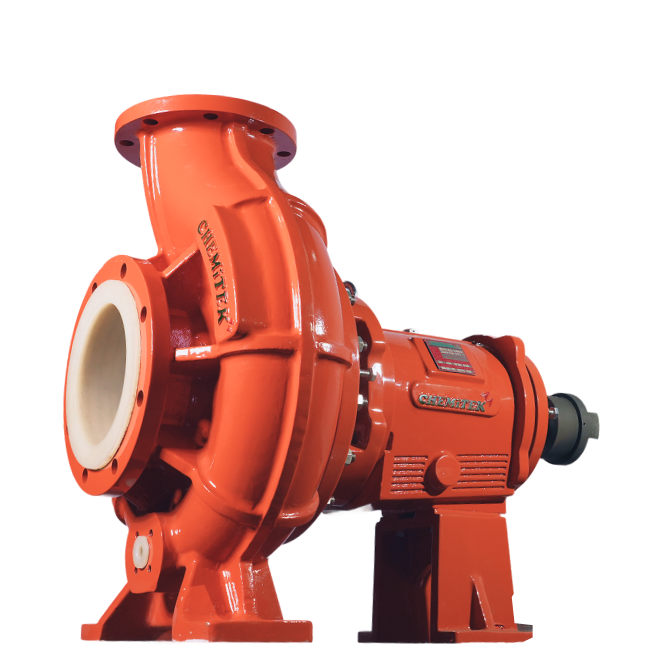
Latest posts
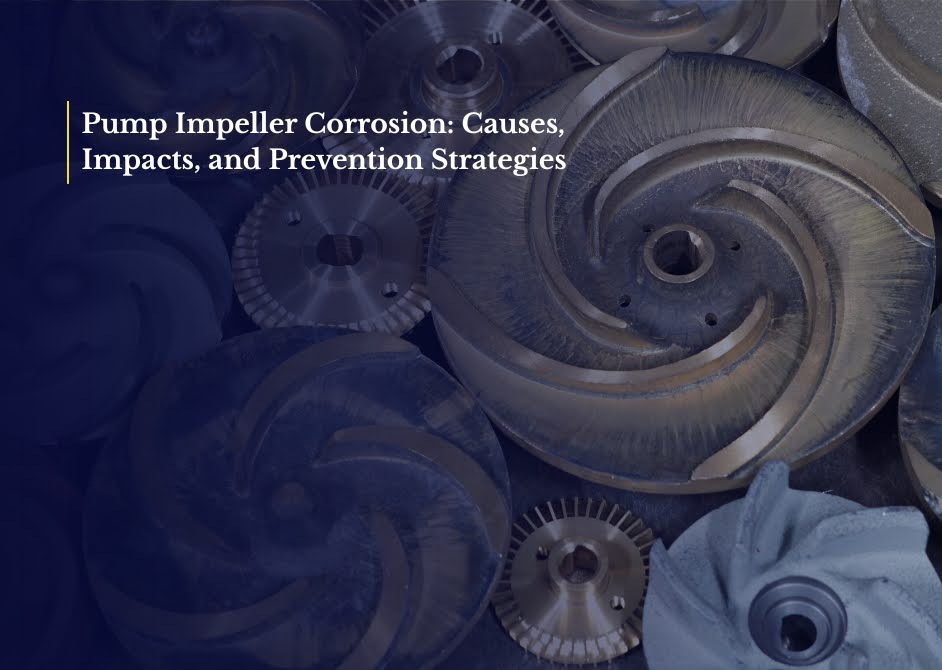
Pump Impeller Corrosion: Causes, Impacts, and Prevention Strategies
Ready to Upgrade Your Process Operations?